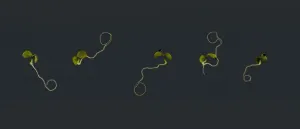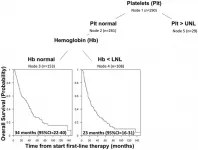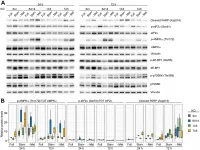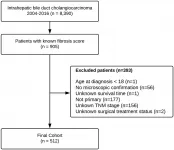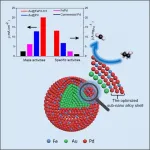(Press-News.org) Scientists have identified that the COVID-19 virus could be transmitted through faecal contaminated river water.
A team of researchers, including water quality, epidemiology, remote sensing and modelling experts, led by Dr Jamie Shutler at the University of Exeter, have developed a fast and simple way to assess the potential risk of water-borne transmission of the COVID-19 virus, posed by sewage spills into open and closed freshwater networks.
The new study, published in the journal Environmental Science and Technology - Water, identifies the relative risk of viral transmission by sewerage spills, across 39 different counties.
The study used information on the environment, a population's infection rate, and water usage to calculate the potential potency of viral loads in the event of a sewerage spill.
The research team believe the new study could provide fresh impetus in identifying new ways in which to prevent the spread of the virus amongst communities and the environment.
Dr Jamie Shutler, lead author of the study and at the University of Exeter's Penryn Campus in Cornwall said: "it's important to identify and break all viable transmission routes if we want to stop any future outbreaks".
Airborne water droplets have previously been highlighted as the main route for transmission of the virus which causes COVID-19, but we know that other forms of transmission are likely to exist.
Previous studies have shown that COVID-19 viral pathogens can be found in untreated wastewater, in concentrations consistent with population infection rates. While studies are still relatively early in relation to COVID-19, other human coronaviruses are documented to survive in wastewater, with colder water temperature likely to increase viral survival.
Using this knowledge and existing methods, the research team identified how the transmission risk from water contaminated with sewage reduces over time.
This issue is likely to be especially problematic in parts of the world with a large proportion of temporary settlements, such as shanty towns, favellas or refugee camps, which are less likely to have safe sanitisation systems. Or any densely populated region that has high infection rates that also suffers from a sewage spill.
Modifying established pollution analysis methods, the team were able to estimate the viral concentration in rivers after a sewage spill. This meant they could calculate the relative transmission risk posed to humans by contaminated waterways for 39 countries.
These methods, the team argue, provides a fast way to assess the transmission risk associated to sewage spills through the use of easily available population, infection rate and environmental data, allowing evidence based guidance following a spill.
Dr Shutler added: "we hope that water companies or NGOs will use our simple spreadsheet calculator, that is freely available, to estimate the transmission risk after a spill. They can then use this information to advise the public."
INFORMATION:
This research was partially funded by the European Union project Aquasense, which is focussing on novel methods to study and monitor water quality.
The research resulted from a collaboration between the University of Exeter in Cornwall, the University of Glasgow, the ?ukasiewicz-Institute of Electron Technology in Poland, and the University of Agriculture in Kraków, Poland.
The fully open access paper is available here:
Shutler et al., (2021) Rapid Assessment of SARS-CoV-2 Transmission Risk for Fecally Contaminated River Water, Environmental Science and Technology Water.
Plants grow towards the light. This phenomenon, which already fascinated Charles Darwin, has been observed by everyone who owns houseplants. Thus, the plant ensures that it can make the best use of light to photosynthesize and synthesize sugars. Similarly, the roots grow into the soil to ensure that the plant is supplied with water and nutrients.
These growth processes are controlled by a hormone called "auxin", which plays a key role in the formation of polarity in plants. To do this, auxin is transported in the plant body polar, from the shoot through the plant body into the roots. In this process, a family of polar transport proteins distributes the auxin throughout the plant. To ...
The cover for issue 49 of Oncotarget features Figure 4, "CART-Tree analysis for overall survival in IMDC intermediate risk group," by Guida, et al.recently published in "Identification of international metastatic renal cell carcinoma database consortium (IMDC) intermediate-risk subgroups in patients with metastatic clear-cell renal cell carcinoma" which reported that as these patients have different prognosis, the aim of this study is to better characterize IR patients in order to better tailor the treatment.
A multivariable Cox model with backward selection procedure and a Classification and Regression Tree analysis were performed to identify which prognostic factors were associated to OS in IR patients.
Median OS for patients with ...
Oncotarget recently published "Exploiting the metabolic dependencies of the broad amino acid transporter SLC6A14" which reported that Tumor cells typically enhance their metabolic capacity to sustain their higher rate of growth and proliferation.
One way to elevate the nutrient intake into cancer cells is to increase the expression of genes encoding amino acid transporters, which may represent targetable vulnerabilities.
The Oncotarget authors analyze the pattern of transcriptional changes in a panel of breast cancer cell lines upon metabolic stress and found that SLC6A14 expression levels are increased in the absence of methionine.
Methionine deprivation, which can be achieved via modulation of dietary methionine intake in tumor cells, in turn leads to a heightened ...
Oncotarget recently published "Effect of liver fibrosis on survival in patients with intrahepatic cholangiocarcinoma: a SEER population-based study" which reported that the impact of fibrosis on overall and cancer-specific survival 12, 36, and 60 months following diagnosis, was evaluated in the entire cohort and in subgroups stratified according to treatment approach and the American Joint Committee on Cancer tumor stage using a Cox proportional-hazards model.
After adjusting for age, sex, race, year of diagnosis, AJCC stage, and surgical treatment strategy, advanced fibrosis was associated with worse cancer-specific survival across follow-up periods.
Similar effects were observed for overall survival.
Among patients that underwent surgical resection, ...
CHICAGO --- Public attitude toward COVID-19 and its treatments is more "infectious" than the disease itself, according to a new Northwestern Medicine study using Artificial Intelligence (AI) to analyze tweets about the virus. Researchers studied the influence of Twitter on COVID-19 health beliefs as well as the competing influence of scientific evidence versus the speeches of politicians.
The study's key findings:
People's biases are magnified when they read tweets about COVID-19 from other users, and the more times it has been retweeted, the more they tend to believe it and retweet it themselves.
Scientific ...
WINSTON-SALEM, N.C. - March 1, 2021 - There is a growing recognition in health care that social factors such as racial bias, access to care and housing and food insecurity, have a significant impact on people's health. Compounding and amplifying those underlying inequalities are the ongoing disruptions related to the COVID-19 pandemic and social unrest in our country.
Although many health care organizations (National Academy of Medicine, American College of Physicians and the American Academy of Pediatrics) currently recommend that screening for social determinants of health (SDH) be included in clinical care, medical education has lagged ...
What The Study Did: Researchers assessed the recruitment and results reporting of randomized clinical trials (RCTs) to treat or prevent COVID-19 registered within 100 days of the first case reported to the World Health Organization.
Authors: Lars G. Hemkens, M.D., M.P.H., of the University Hospital Basel in Basel, Switzerland, is the corresponding author.
To access the embargoed study: Visit our For The Media website at this link https://media.jamanetwork.com/
(doi:10.1001/jamanetworkopen.2021.0330)
Editor's Note: The article includes conflict of interest and funding/support disclosures. Please ...
Researchers from the Institute of Process Engineering (IPE) of the Chinese Academy of Sciences and Nanjing Normal University recently reported a strategy for boosting the electrocatalytic performance of palladium (Pd) in ethanol oxidation reaction, the key anodic reaction of direct ethanol fuel cells (DEFCs), offering a rational concept for finely engineering the surface of electrocatalysts used in high-efficiency energy conversion devices and beyond.
The study was published in Cell Reports Physical Science on Mar. 1.
DEFCs, with ethanol as fuel, have the advantage of high energy density, low toxicity and easy operation. However, the lack of active and robust electrocatalysts ...
Rising temperatures could reduce the efficiency of food chains and threaten the survival of larger animals, new research shows.
Scientists measured the transfer of energy from single-celled algae (phytoplankton) to small animals that eat them (zooplankton).
The study - by the University of Exeter and Queen Mary University of London, and published in the journal Nature - found that 4°C of warming reduced energy transfer in the plankton food webs by up to 56%.
Warmer conditions increase the metabolic cost of growth, leading to less efficient energy flow through the ...
Researchers in the Muir Lab at Princeton University's Department of Chemistry have completed the first comprehensive analysis of cancer-associated histone mutations in the human genome, featuring both biochemical and cellular characterizations of these substrates. Their study reports that histone mutations that perturb nucleosome remodeling may contribute to the development or progression of a wide range of human cancers.
Within the human genome, DNA is wrapped around disc-shaped structures made up of eight histone proteins, each forming nucleosomes. Repeating nucleosome units comprise chromatin, a storehouse of genetic information that is both structured and dynamic. Broadly, the Muir Lab seeks to understand how chromatin controls genetic processes in the cell and how disruption ...
